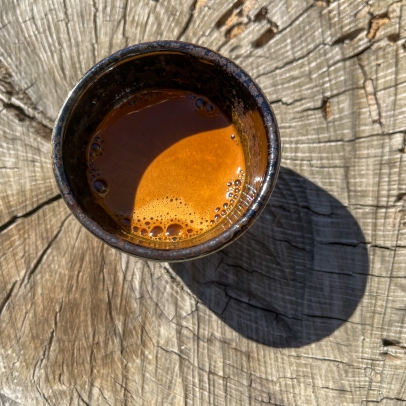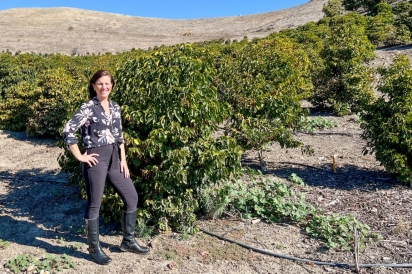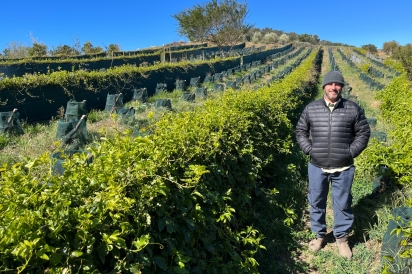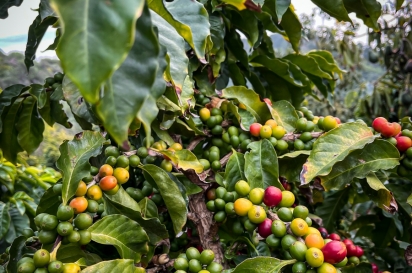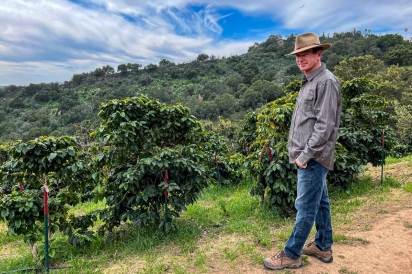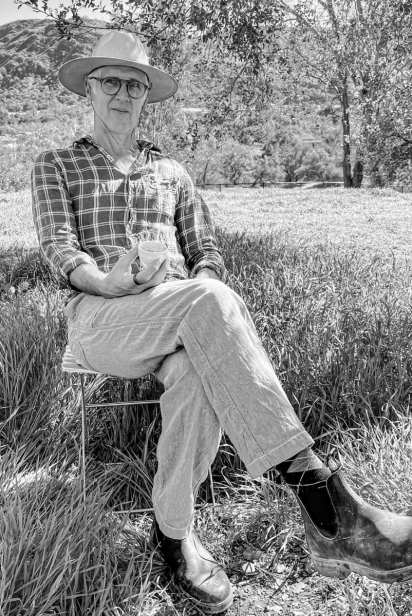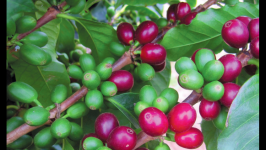The Case for Couture Coffee
The Experience
On March 3, 2022, I had a transcendental coffee experience. Granted, I tend to make preposterous claims and feel an extraordinary exuberance for life when I’m over-caffeinated. I’d already had three cups of coffee and a shot of espresso by the time I showed up at Jay Ruskey’s farm in Goleta. Jay, CEO and co-founder of Frinj Coffee—a company that works with over 70 farms that grow coffee in Santa Barbara, Ventura and San Diego counties—directed me into a modern yet rustic, airy, light-filled barn that I quickly realized is a state-of-the-art coffee laboratory.
In one corner stood a man with a clipboard studying his roast profile notes around an avante-garde San Franciscan coffee roaster. Bustling up and down from a lofted space, coffee mugs and laptops in hand, were various administrative staff. My eyes gravitated toward the display on an otherwise impeccably clean stainless kitchen island: a vintage stainless water pitcher, various glasses, a scale and small sample bags of coffee, all arranged amidst freshly cut vines of crimson coffee berries on a rustic oak slab.
Jay wasted no time filling two large glasses with sparkling water and squeezing caviar limes into each one, “to cleanse our palates.” For the next 20 minutes, Jay slowly poured water over his precisely ground Caturra and Gesha beans, the premier varieties of coffee in the world. Typically, these high-end coffees are grown around the equator and sold to markets in Asia, but Jay Ruskey and his coffee venture are anything but ordinary.
“How does it taste?”
As a former small craft coffee business owner who has visited countless farms (closer to the equator) with a somewhat-judgemental coffee-fanatic mind-set, I was surprised to find myself savoring each sip of these California brews.
“Extraordinary.”
Why Are VC Farmers Growing Coffee?
Lisa Tate farms on the family land purchased in the late 1920s by her great grandfather, now part of family-owned Rancho Filoso. With decades of farming experience in her back pocket, and a recognition of the challenges presented by climate change, the Asian Citrus Psyllid and even global trade issues, she saw the need to continue to diversify her crops. Lisa took what she describes as a “new, exciting opportunity” and added 1,295 coffee trees on one and a half acres. Shortly after, the Thomas fire burned through her land and many avocado trees, but left the coffee standing.
David Hertz, a leader in sustainable architecture and regenerative design, sought out coffee plants to safeguard his home in the face of climatic disasters. He has planted 550 trees as a high-humidity windbreak zone to protect his Ventura County property from future fires. David found that while “avocados and citrus have lost their resistance to pests, coffee does not have pests in California because it’s such a new plant here.” He has heightened awareness of climatic changes, especially given the Thomas Fire and more frequent 90 mph gusts of wind on his property. David planted coffee, alongside passion fruit hedges, “to mitigate risk.”
The past year was one of the driest and hottest on record in California, and comes during a larger 22-year megadrought in the West that research shows is being worsened by climate change. The U.S. Department of Agriculture has designated Ventura County as a “primary natural disaster area” due to drought.
Many farmers in this area have an increased understanding that they must grow produce not as monocrops, but rather as a mix of diverse, symbiotic crops that regenerate the soil and conserve as much water as possible. Coffee plants require a significant amount of water, about equivalent to that used by avocado trees, even with the most carefully managed, precision irrigation and cutting-edge soil regeneration techniques. Nonetheless, local coffee farmers assert coffee’s benefits to the overall farm system outweigh the costs.
“Diversity is key,” says Jay Ruskey. “With a layered agriculture system that includes plant species like coffee, we’re creating a resilient system that offers protection from an increasingly turbulent environment.” Indeed, his coffee farm is a tropical utopia—not only are the coffee plants robust, but the diverse array of plant, insect and bird species thriving alongside his coffee is awe-inspiring.
The changing markets have encouraged farmers to seek alternative crops, like coffee. In 2017, the Trump Administration lifted a 16-year lemon import ban and allowed Argentine lemons into the United States, saturating the market and lowering lemon prices, while as of January 1, 2022, labor prices are rising. Given this ever-changing and challenging environment, resilient and visionary farmers understand coffee as a sustainable business option. Jay contends that a farmer can realize an additional $5,000–$8,000 per acre by adding coffee plants under an avocado tree canopy. Blue Bottle Coffee founder and Ojai coffee grower James Freeman words it succinctly: “Coffee is a way to diversify and potentially save farmers’ livelihoods.”
Grow Coffee? In SoCal??
After 20 years growing coffee in California, Jay Ruskey has well-established proof that coffee grows well anywhere avocados grow. That said, starting a coffee farming production in California is a long-term, arduous investment. Coffee trees can live for over 35 years in other parts of the world, and take four years before they produce viable coffee beans. Wind is a concern, and these tropical plants don’t like freezing temperatures. However, in the right, protected areas, and with thoughtful cultivation, coffee plants flourish here. David Hertz and other Ventura County farmers are using “biochar,” a charcoal-like substance that’s made by burning organic material from agricultural and forestry wastes (also called biomass) in the planting hole. They are also interspersing other plants, like passion fruit, dragon fruit or Inga trees, to provide necessary nitrogen, sun and wind protection.
California coffee plants aren’t just surviving, they’re thriving. California coffee farms are located farther from the equator than traditional coffee farms, which means the cherries take twice as long to ripen, and the taste is more “defined” and “some of the sweetest in the world,” according to Jay Ruskey. The professional coffee world agrees: his Caturra 2014 crop, the first California-grown coffee to ever be tested, was rated 27th in the world with a score of 92, which is considered “exceptional.” Co-owner of Ragamuffin Coffee Roasters Shawn Pritchett, a partner with Lisa Tate in the coffee processing venture, California Coffee Collective, reported that Rancho Filoso’s 4-year-old crop of 2020 Gesha was professionally rated at 89.25, which is also excellent, especially considering coffee is not considered mature until year five.
The Cost of California Coffee
High-caliber California coffee comes at a high price: $160–$283 per pound, or around $16 a cup at a Blue Bottle coffee shop.
There are many factors that justify this cost of California coffee relative to the cost of coffee grown in developing countries, including the cost of land, water and labor. To address labor in particular, coffee cherries can’t just be picked and sold like an avocado or an orange. Coffee is an especially painstaking venture that involves planting, harvesting, floating, pulping, fermentation, drying, hulling, roasting, grinding and brewing—ideally with the utmost care during each of these steps.
Moreover, California conditions are unique relative to Latin America and other coffee-growing regions, in part due to distance from the equator—here, the fruit takes roughly two to four months longer to mature, meaning California farmers harvest only half the coffee cherries compared to typical commercial coffee growers, and must manage the plants for a longer period of time. California farmers are highly valued for this skilled work, and paid accordingly.
“The goal is to support the farmer first. We try to get the highest price for our coffee as possible, then give half that value back to the farmer,” says Jay.
Given the higher costs for land and labor, the profit margins on a pound of coffee are similar in California as conventional coffee-growing regions like Ethiopia and Mexico, where production costs are much lower. As in, very low. The biggest barrier? “Perception,” says Jay. “People are willing to pay $12 for a five-ounce glass of wine, but only 25 cents for a five-ounce cup of coffee.”
A Fruitful Trend?
Despite the obstacles and risks associated with shifting to an entirely new crop like coffee, Ventura County farmers may soon see the fruits of their labor, literally. In 2017, Blue Bottle purchased 250 pounds of Gesha beans from Jay Ruskey, sold the coffee at $16 a cup, and sold out in two weeks. In 2019, Bird Rock Roasters sold 20 pounds of California-grown Gesha coffee at $100 for 4 ounces within hours.
We can expect further growth along this trajectory as more nascent coffee trees in Ventura County begin to bear fruit for harvesting. Just as Jay compared the costs of wine and coffee, he likes to compare the wine market to the potential of the coffee market: “We are on the path wine was on years ago, so the hope is to grow as the wine industry has done in California.”
An important part of this wine analogy is the effort California growers are making to elevate coffee drinking to a farm-to-table sensory experience. Frinj Coffee’s Instagram includes detailed tutorials on the proper equipment and ratios to achieve the perfect brew, which makes sense if you don’t want to mess up that $20 cuppa! At this price point, you don’t just grab a coffee to-go and gulp it down for a jolt of energy, you relish it, ideally slowly and in the company of others with whom you can extol the virtues of the different coffee notes, like a fine wine. Originally from Gesha, Ethiopia (hence the name), these beans have been grown with the most success in Panama, where it has set high-ranking records in competitions since 2004, recently selling for $1,300 a pound in 2020. These coffees sell well in Asian markets where the culture is accustomed to enjoying expensive fine teas, as the Gesha bean has a lightly roasted, tea-like quality. A coffee of this caliber is the only one that makes sense financially for California given the production costs, but it requires creating a culture here that appreciates premium coffee enough to pay the price.
What Does California’s Couture Coffee Culture Look Like?
James Freeman likes to run weekly hill sprints on his property with buddies, then invite his fellow runners over to his “coffee shed” for espresso drawn from his enviable Faema machine, and “marvel at the vicissitudes of fate which brought us all to Ojai, sipping espresso, under these majestic oaks” overlooking the Topatopa Mountains and his coffee trees.
Lisa Tate and Shawn and Sarah Pritchett of Ragamuffin Roasters co-own the California Coffee Collective which works closely with Rancho Filoso to host coffee harvesting events, tours and cupping events.
David Hertz also plans to invite people over to his “Xanabu” ranch for “coffee events” that involve learning about and tasting coffee on his massive deck made of fantastical gold and weathered teak, which is the original stage set from the musical The King and I.
Jay Ruskey offers “exclusive experiences that will take you on a sensory journey of coffee and tropical fruit and give you a glimpse into the future of Southern California agriculture” that includes “guided tastings of Frinj Coffee’s specialty pour-over brews, pastries from a local bakery, and a guided educational ranch tour with multiple fruit tastings along the way.” These experiences are unique, social ways to take coffee lovers to the “next level” in their coffee drinking.
I’m somewhat ambivalent about California’s couture coffee culture. On the one hand, it’s luxuriously delightful, and Jay’s Gesha pour-over was the best I’ve ever tasted. I admire California coffee entrepreneurs’ efforts to treat farmers, and the land, well. On the other hand, like the wine movement, the price point puts this premium commodity out of reach for a huge percentage of the population. Controversy over whether limited resources like water should be used on an exclusive product raises valid questions. We have entered a new era of catastrophic climatic shifts, and farmers are left with few options to maintain their livelihoods.
In conclusion, if couture coffee can keep California farmers in business, then I will indulge my coffee obsession and splurge on the $20 cup of gesha and guided coffee sipping experiences in paradise. Who knows? Maybe sharing transcendental California coffee experiences with hyper-caffeinated friends will inspire more of the creative environmental solutions we need.
For more about California coffee growers visit FrinjCoffee.com, BlueBottleCoffee.com or CaliforniaCoffee.com.


